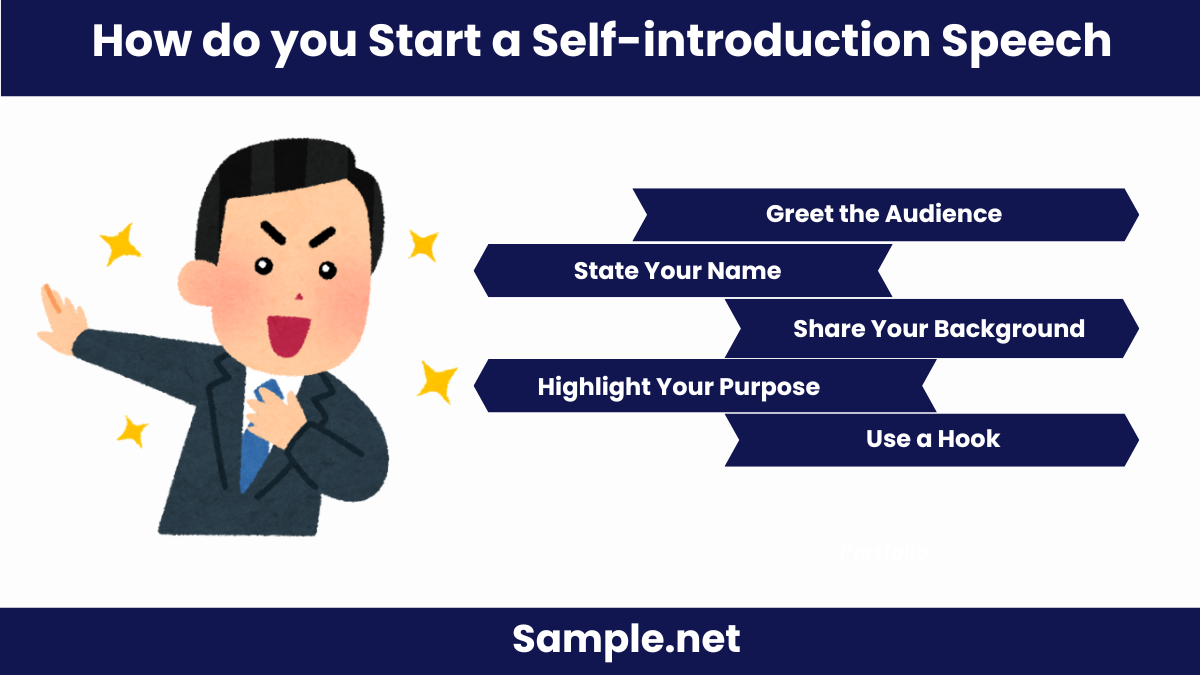Download Self-Introduction Speech Bundle
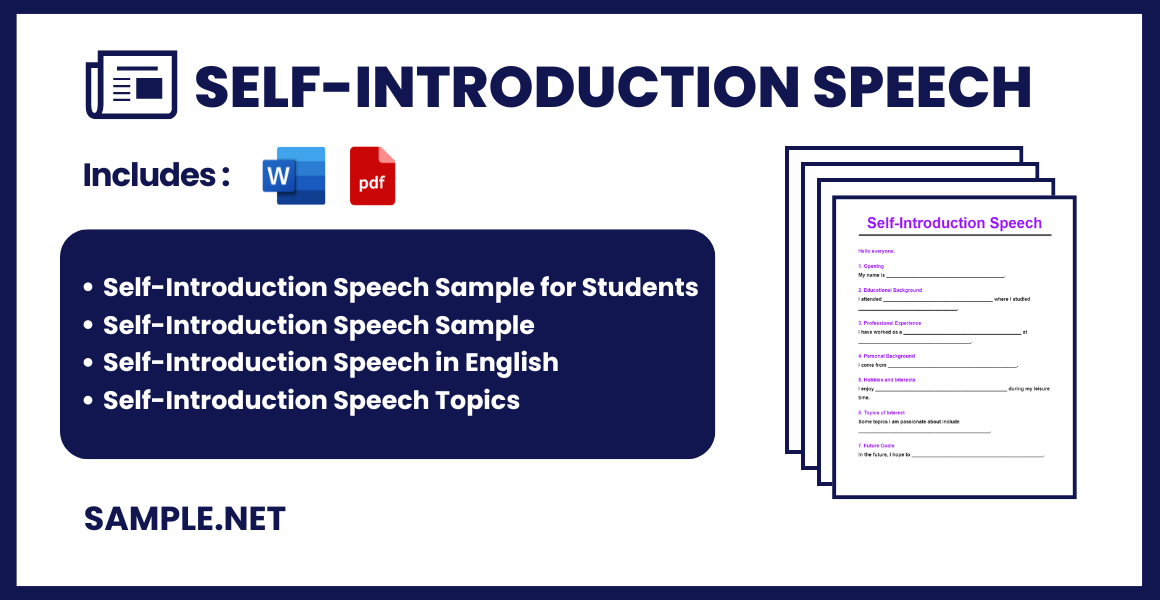
Self-Introduction Speech Format
1. Greeting
Good [morning/afternoon/evening] everyone.
2. Introduction
My name is [Your Name], and I am [brief description about yourself, e.g., your current role or your background].
3. Background Information
- Education: Share brief details about your educational background.
- Experience: Highlight your professional experience or relevant personal experiences.
- Skills: Mention key skills or attributes that define you.
4. Personal Touch
Include a personal anecdote or interesting fact about yourself to engage the audience.
5. Conclusion
Thank you for listening. I am excited to be [part of this event/working with you/etc.]. Feel free to ask any questions.
Self-Introduction Speech Samples
-
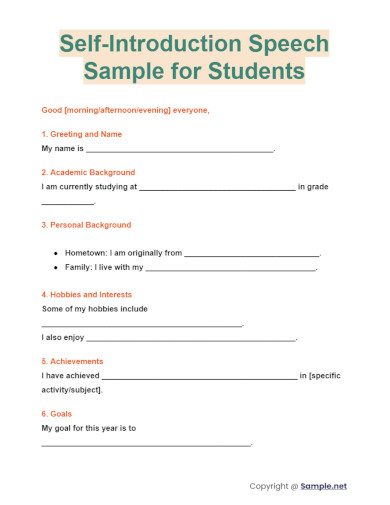
Self-Introduction Speech Sample for Students
download now -
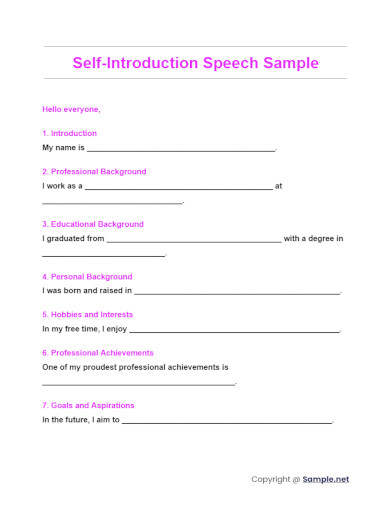
Self-Introduction Speech Sample
download now -
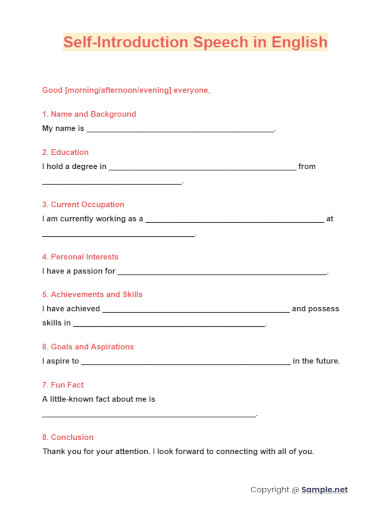
Self-Introduction Speech in English
download now -
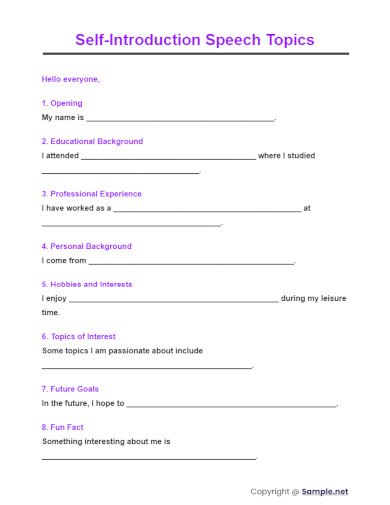
Self-Introduction Speech Topics
download now -
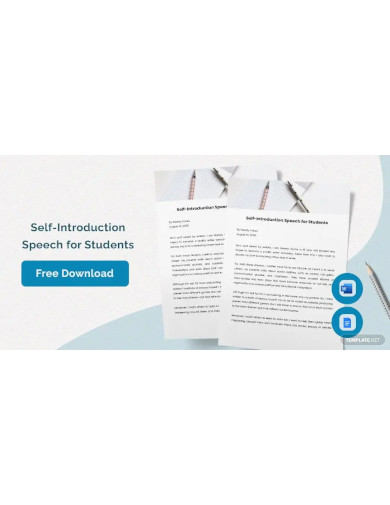
Free Self Introduction Speech For Students
download now -
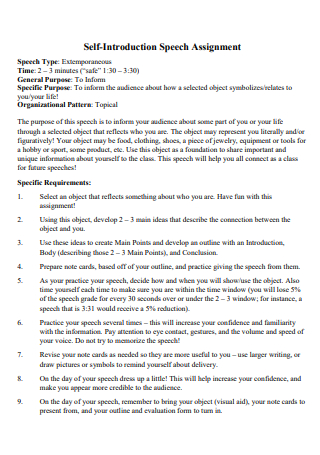
Self-Introduction Speech Assignment
download now -
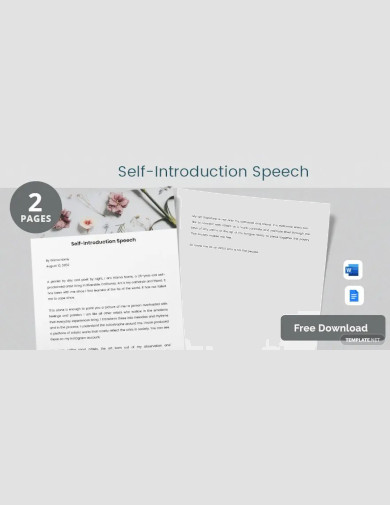
Self Introduction Speech
download now -

5 Minute Self Introduction Speech
download now -
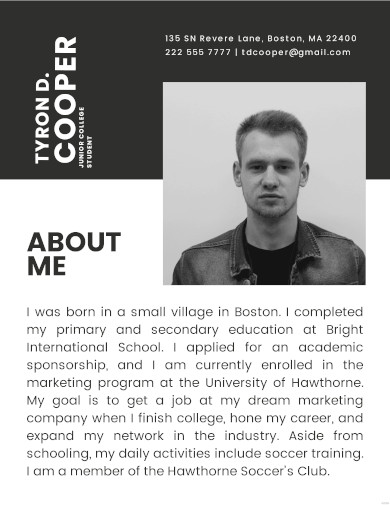
Self Introduction For College Students
download now -
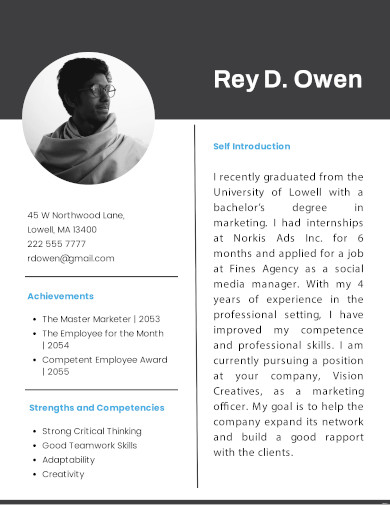
Self Introduction For Job
download now -
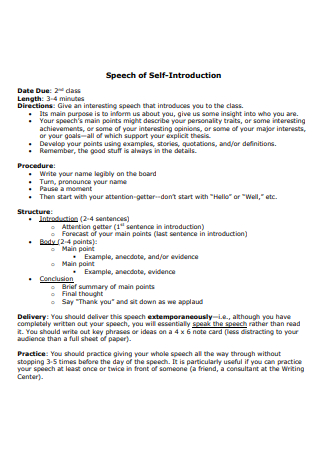
Self-Introduction Speech Template
download now -
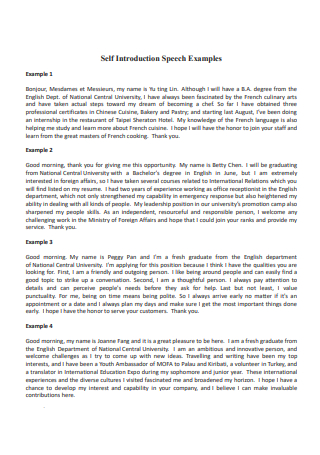
Self-Introduction Speech Example
download now -
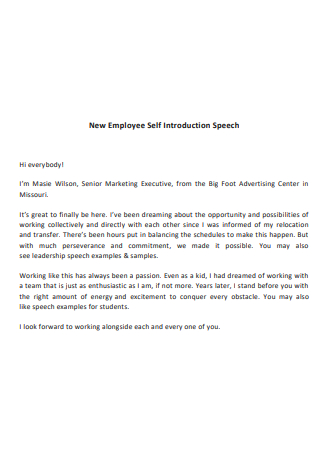
New Employee Self-Introduction Speech
download now -
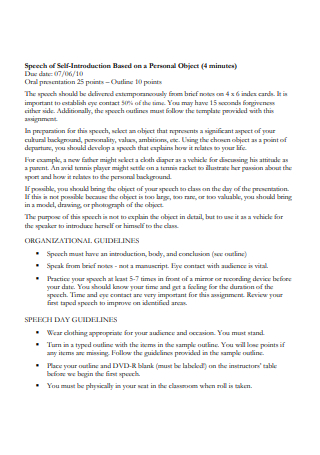
Self-Introduction Speech in PDF
download now -
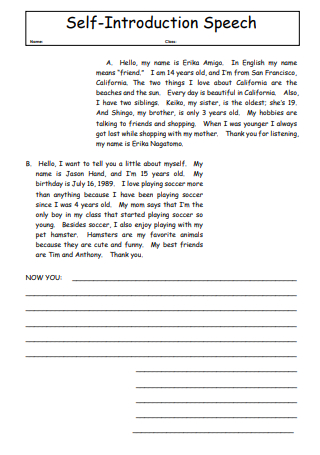
Formal Self-Introduction Speech
download now
What is Self-Introduction Speech?
A self-introduction speech is a brief presentation where you introduce yourself to an audience, providing essential information about your background, interests, and goals. This speech aims to establish rapport and leave a positive impression. It’s often used in professional, academic, and social settings to effectively communicate who you are and what you stand for. A well-crafted self-introduction speech includes key details such as your name, occupation, relevant experiences, and personal interests, creating a comprehensive snapshot of your identity for the audience.
Moreover, different kinds of presentations include a self-introduction speech as it usually takes about 10-15% of the speaking time. That’s why the first 15 seconds matter so that you are able to create a good first impression to the public. Thus, it is very important for all students, new employees, working professionals, and other public speakers to develop a compelling and effective self-introduction speech.
Different Types of Self-Introduction Speech
There are a wide array of ways to introduce yourself in the public. It is not about telling about yourself but you need to pitch yourself to the audience so that they are able to keep their attention and interest throughout your entire talk. However, there are many different events or occasions where you would have to introduce yourself before the presentation. Below are different types of self introduction speech in various settings that you may consider:
1. Self-Introduction Speech for Public Speaking Class
Dale Carnegie, an American writer and lecturer and developer of popular courses in self-improvement and public speaking, wrote in his book The Art of Public Speaking that facing an audience as frequently as you can will help you to stop shying, and always practicing in speaking in front of an audience will tend to eliminate all fear of audiences. Like how a person practices in swimming will lead to confidence and facility in the water, you need to learn to speak by speaking. You also need to become absorbed in your subject as you fill your mind with your speech material. That’s why enrolling in a public speaking class is a great way to help yourself to be confident during interviews, giving presentations or getting up close and personal with others. Developing an effective self-introduction in a public speaking class is a good way to allow the students and teacher in your class to be familiar with you.
2. Self-Introduction Speech for College Students
Are you a college student who always shied away from giving presentations? A 2013 survey conducted by the National Association of Colleges and Employers revealed that employers look for people who can communicate effectively. That’s why you need to come out of your cocoon and be determined to do your best in speaking to the public. One way to practice your communication skills is to create an introductory speech. This will help you to combat your fears and gain confidence while telling people about yourself. Also there are many majors which are already working toward making public speaking as a mandatory course because it is integral for most career paths and in our daily life. So, creating a self introduction speech for college students is essential in facilitating presentation skills and it can help you out in your future presentations.
3. Self-Introduction Speech in Business Settings
It is common to introduce yourself in the workplace. Preparing a short introduction about yourself is important so that you’re able to answer the interview question being brought up. If you are a team leader, you need to introduce yourself and your team and demonstrate the performance report of the company. Or if you are a new entrepreneur, you need to have a solid pitch to get potential investors to fund your start-up. On the other hand, a freelancer like a copywriter should make a self-introduction speech to his or her client in order to draw the client’s attention to his or her skills and competencies.
4. Self-Introduction Speech in Meetings, Seminars, Training, and Workshops
An enticing self introduction can put you ahead of the game before talking about your project or a particular topic or subject in meetings, seminars, training, and workshops. You need to be confident and on point as you deliver your speech. Emphasize your personal experiences in the form of a story or you may start with how it was when you worked with one of the best clients in the industry.
Benefits of a Self-Introduction Speech
The University of California, Los Angeles campus reported about public speaking that approximately 7% of the message comes from the words, 36% of the message comes from the voice and 57% of the message comes from the nonverbal communication. This means that body language is a fundamental element in presenting all kinds of speech like a self-introduction speech. Then, what are some of the notable benefits of a self-introduction speech? Kindly read the following information:
1. Builds Worthwhile Connections
Writing an effective self introduction speech outline is beneficial when it comes to building and maintaining worthwhile connections. This will create the difference between being evaluated positively or negatively, being believed or doubted, or delivering an effective or ineffective presentation. That’s why you need to focus on your common values, goals and experiences that exist between you and your audience. When it comes to improving the evaluation and perception of an audience to a speaker, you need to perform certain behaviors during the delivery of a presentation. Through an increased eye contact, relaxed posture and smiling, you can properly build worthwhile connections with the audience.
2. Facilitates Self-Confidence
Nic Sheff said: “As long as you look for someone else to validate who you are by seeking their approval, you are setting yourself up for disaster. You have to be whole and complete in yourself. No one can give you that. You have to know who you are – what others say is irrelevant.” So, avoid validating yourself by seeking the approval of other people. Instead, you need to feel whole and complete, acknowledging who you are. Preparing a self-introduction speech will help you to facilitate your self-confidence while you look at your personal achievements, contemplate on the things you are good at, and tell others about yourself in order to inspire and motivate them.
3. Allows Deep Understanding and Positive Thinking
Constructing a comprehensive self-introduction speech allows deep understanding and positive thinking. This method helps you to discover and deeply understand why you have certain qualities, skills, and other aspects about yourself. Making a list of meaningful aspects of yourself can help you to visualize, affirm, and keep your thoughts on them to the greatest extent. The Power of Positive Thinking explained that feelings of confidence depend on the type of thoughts that habitually occupy your mind. The constant practice of thinking confident thoughts and making it a dominant habit will help you to develop a strong sense of capacity. This is crucial when difficulties arise in front of you, you will be able to overcome them.
4. Improves Communication Skills
A self-introduction speech also improves one’s communication skills. Communicating to other people not just involves exchanging information but it also focuses on understanding the emotion and intentions regarding the information. Showing your confidence, friendliness, empathy, and respect while introducing yourself can help you to reach the flying colors in your career. Plus, effective communication in personal and professional settings is crucial in providing clarity and direction, improving engagement, and promoting team building.
Basic Components of a Self-Introduction Speech
In this section, you will learn how to craft an impeccably-written self-introduction speech so that you are able to draw the attention of your target audience. However, a self-introduction speech contains different kinds of components. Take into account of the following elements of a self-introduction speech outline for you to create a systematic document:
How to Write a Self-Introduction Speech
Studies have shown that 75% of people suffer from speech anxiety or glossophobia before giving a presentation or public speech. You need to exert much effort and dedication in gaining your audience’s attention and making them interested in what you are saying. Avoid assuming that people will just simply listen because the speaker is speaking. In this matter, we suggest that you follow the simple steps below while freely using one of our self-introduction speech examples in this article:
Step 1: Use Different Kinds of Attention-Getting Methods in Various Self-Introduction Settings
The first step you need in order to capture the attention of your audience is using different attention-getting tools and methods based on various self-introduction settings. Some different types of tools and methods are reference to audience, reference to subject, reference to current events, reference to occasion, quotation, historical reference, anecdote, startling statement, humor, personal reference, and question. For example, using a great quotation from the articles of books you have read is an effective method in getting the attention of your audience and heightening their curiosity of your speech.
Step 2: Include a Clear Overview of Yourself
Next, include a clear overview of yourself as you greet the audience and tell about your strength or any valuable and special trait in one or more than two words. Spend some time to observe and reflect on what you have already accomplished and consider the things you are good at. List down your noteworthy talents and other skills. Simply describe your accomplishment reports or contributions while maintaining a humble tone.
Step 3: Add a Short Timeline of Your Education or Career
Let your audience know about the history or timeline of your education or career. This will help you to make yourself appear competent and skilled. Explain to your audience an educational qualification or a career position. Tell them why you selected a particular educational course or specific career path.
Step 4: Highlight Meaningful Contributions
What are your meaningful contributions in a particular field in our society? Point out the unique value and contribution of your work. Tell your audience the significance of your work as you identify how your personal project or professional work fits into an extensive area of a particular field. Unfold the tangible outcomes from your work.
Step 5: Demonstrate Brevity and Coherence
Your self-introduction speech should be short yet powerful to impress your audience. So, demonstrate brevity in your speech. On the other hand, coherence is crucial in keeping the smooth flow of the sentences together. Integrate some devices to associate ideas within each sentence and paragraph in order to establish the logical bridge between words, sentences, and paragraphs. The attention-getting method from the start of your speech should coincide to the topic of your speech. You also browse our Autobiographical Speech
Step 6: Prepare the Final Draft
Have some adequate time to draft your self-introduction speech. Expect that your speech will have to undergo multiple revisions. Ask for some help from your classmates or work colleagues and other professionals in the field you have been working for efficient proofreading and revision of your document. Then, practice your speech with your choice of audience like your family or close friends. After that, prepare the final draft of your self-introduction speech.
What are the different kinds of attention-getting methods in self introduction?
The different kinds of attention-getting methods in self introduction that you can use in various settings are reference to audience, reference to subject, reference to current events, reference to occasion, quotation, historical reference, anecdote, startling statement, humor, personal reference, and question.
What are the fundamental components of a self-introduction speech?
When preparing your self introduction speech, you need to consider these fundamental elements such as your name, background, position, interest, passion, and other personal details relevant to the setting of your speech. Then, include a surprise element and tell a story about yourself. You also browse our Self-Declaration
What are some examples of a self-introduction speech?
Some examples of a self introduction speech are self introduction speech for public speaking class, self introduction speech for college students, self introduction speech in an interview, new employee self introduction speech, and self introduction speech for club meetings. You also browse our Biodata Form
What is the purpose of a self-introduction speech?
The purpose of a self introduction speech is to inform the public about yourself, telling the audience your name, background , hobbies, interest and many other important elements necessary in a particular meeting or occasion. It is often used in work seminars, a breakout group at a conference, a hobby group or a new class at the beginning of the term in order to establish a sense of belonging. You also browse our Biopsychosocial Assessment
How do you start a self-introduction speech?
Starting a self-introduction speech effectively is crucial for making a strong first impression. Follow these steps for a powerful opening:
1. Greet the Audience
Begin with a warm greeting to establish a connection. A simple “Good morning/afternoon/evening” works well.
2. State Your Name
Clearly state your full name to ensure the audience knows who you are.
3. Share Your Background
Briefly mention your background, such as your profession, education, or where you are from. This sets the context.
4. Highlight Your Purpose
Explain why you are speaking and what you aim to achieve. This gives your speech direction.
5. Use a Hook
Start with an interesting fact, quote, or question to grab the audience’s attention and make them want to listen. You also browse our Biography
How do you introduce yourself professionally in one minute?
Introducing yourself professionally in one minute requires conciseness and clarity. Here’s a step-by-step guide:
1. Name and Position
Begin with your name and current job title or role. This provides immediate context.
2. Company or Organization
Mention the name of your company or organization to establish your professional background.
3. Brief Job Description
Provide a short description of your role and responsibilities, highlighting your key contributions.
4. Relevant Experience
Briefly touch on your relevant experience or achievements, like a highlight in your Self Declaration Statement.
5. Closing Statement
End with a statement that connects you to the audience, such as your goals or what you hope to achieve in the interaction.
How can I start my self introduction example?
Starting your self-introduction with an example makes it relatable and engaging. Follow these steps for a strong start:
1. Use a Personal Story
Begin with a brief personal story that relates to the context of the introduction.
2. Relate to the Audience
Connect your story to the audience’s interests or experiences.
3. Highlight Key Points
Use your story to highlight key points about yourself, such as skills or experiences from your Self Assessment.
4. Keep It Concise
Ensure your story is brief and to the point to maintain the audience’s interest.
5. Transition Smoothly
Transition smoothly from your story to the main content of your introduction.
What to say in a two minute speech about yourself?
In a two-minute speech about yourself, you need to be concise and engaging. Here’s how to structure it:
1. Introduction
Start with your name and a brief background, such as your profession or education.
2. Key Experiences
Highlight one or two key experiences that define you professionally or personally, similar to points in an Appraisal Self Evaluation.
3. Skills and Strengths
Mention your main skills and strengths that are relevant to the context.
4. Personal Interests
Share a couple of personal interests or hobbies to give a fuller picture of who you are.
5. Closing Remark
End with a closing remark that ties everything together and leaves a lasting impression.
What is the easiest way to introduce yourself?
The easiest way to introduce yourself is to keep it simple and direct. Follow these steps for a smooth introduction:
1. Start with Your Name
Begin by stating your full name clearly.
2. Mention Your Role
Briefly mention your current role or what you do.
3. Add a Personal Touch
Include a personal detail or interest to make the introduction more engaging, as you would in a Self Assessment Plan.
4. Keep It Short
Keep your introduction short and to the point.
5. Practice
Practice your introduction to ensure it flows naturally.
What are the 3 sentences that go in an introduction?
A strong introduction can be achieved with just three sentences. Here’s a guide:
1. Name and Role
Introduce yourself with your name and current role.
2. Key Experience or Skill
Mention a key experience or skill that is relevant to the context.
3. Connection to Audience
End with a sentence that connects you to the audience, similar to an Informative Speech Thesis Statement.
How do you write 5 sentences about yourself?
Writing five sentences about yourself requires focus on key aspects. Here’s how:
1. Personal Introduction
Start with your name and a brief personal detail.
2. Professional Role
Mention your current professional role or occupation.
3. Key Skill or Experience
Highlight a key skill or significant experience, akin to what you would include in a Self Evaluation Essay.
4. Personal Interest
Include a personal interest or hobby.
5. Future Goal
End with a sentence about your future goal or aspiration.
What is a good start for self-introduction?
Begin your self-introduction with a warm greeting, followed by your name and a brief professional background. Similar to a Faculty Self Assessment, it sets a clear and positive tone.
What do I say when I introduce myself?
When introducing yourself, mention your name, current role, and a key professional or personal detail. It’s like creating a Self Storage Business Plan—concise and informative.
What is the best opening line for a speech?
Start your speech with an engaging question, a relevant quote, or an interesting fact. This approach, like Self Evaluation, immediately captures attention and sets the stage.
What is the best sentence to introduce yourself?
The best sentence to introduce yourself is, “Hello, I’m [Your Name], a [Your Profession] with a passion for [Your Interest],” akin to a Self Assessment Checklist—clear and straightforward.
How do you start a speech to grab attention?
Start your speech with a compelling anecdote, surprising fact, or thought-provoking question. This method, like a well-written Self Review, hooks the audience from the beginning.
What is an attention getter for introducing yourself?
An effective attention getter for introducing yourself is sharing a personal story or unique experience. Similar to an Annual Self Evaluation, it makes your introduction memorable.
How do I introduce myself in a unique way?
Introduce yourself uniquely by highlighting a distinctive skill or experience, like presenting your Self Employee Receipt detailed and personal. This approach stands out and engages the audience effectively.
In conclusion, mastering a self-introduction speech is crucial for making impactful first impressions. This article provided a comprehensive overview of various formats, samples, and practical tips for crafting an engaging self-introduction. By using these strategies, you can confidently introduce yourself in any setting. Whether you’re preparing a speech for a job interview, networking event, or casual introduction, the techniques shared will enhance your presentation. Additionally, incorporating elements like a Personal SWOT Analysis can add depth and authenticity to your speech. Use these insights to refine your self-introduction and connect meaningfully with your audience.
